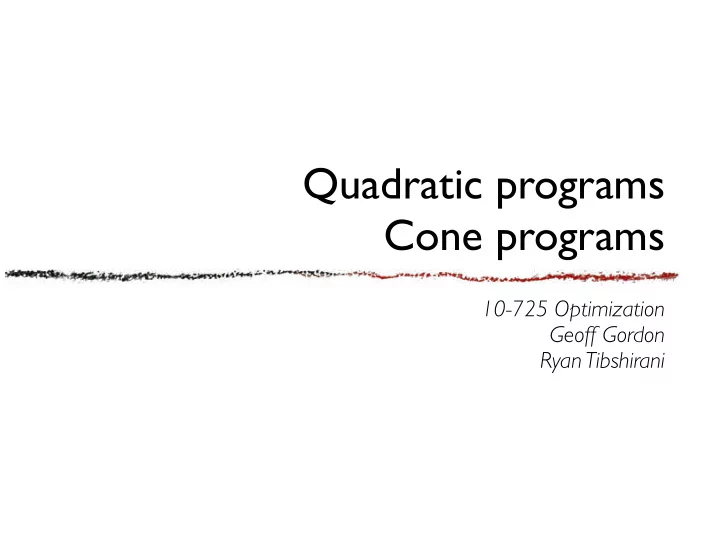

Quadratic programs Cone programs 10-725 Optimization Geoff Gordon Ryan Tibshirani
Administrivia • HW3 back at end of class • Last day for feedback survey • All lectures now up on Youtube (and continue to be downloadable from course website) • Reminder: midterm next Tuesday 11/6! ‣ in class, 1 hr 20 min, one sheet (both sides) of notes Geoff Gordon—10-725 Optimization—Fall 2012 2
Quadratic programs • m constraints, n vars ‣ A: R m ! n b: R m c: R n x: R n H: R n ! n ‣ [min or max] x T Hx/2 + c T x ‣ s.t. Ax " b or Ax = b [or some mixture] ‣ may have (some elements of) x # 0 • Convex problem if: max 2x+x 2 +y 2 s.t. x + y " 4 ‣ 2x + 5y " 12 x + 2y " 5 x, y # 0 Geoff Gordon—10-725 Optimization—Fall 2012 3
For example Geoff Gordon—10-725 Optimization—Fall 2012
Cone programs • m constraints, n vars ‣ A: R m ! n b: R m c: R n x: R n ‣ Cones K ⊆ R m L ⊆ R n ‣ [min or max] c T x s.t. Ax + b ∈ K x ∈ L ‣ convex if • E.g., K = • E.g., L = Geoff Gordon—10-725 Optimization—Fall 2012 5
For example: SOCP • min c T x s.t. A i x + b i ∈ K i , i = 1, 2, … Geoff Gordon—10-725 Optimization—Fall 2012 6
Conic sections Geoff Gordon—10-725 Optimization—Fall 2012 7
QPs are reducible to SOCPs • min x T Hx/2 + c T x s.t. … Geoff Gordon—10-725 Optimization—Fall 2012 8
! SOCPs that aren’t QPs? • QCQP: convex quadratic objective & constraints • minimize a 2 + b 2 s.t. ‣ a # x 2 , b # y 2 ‣ 2x + y = 4 • Not a QP (nonlinear constraints) ‣ but, can rewrite as SOCP Geoff Gordon—10-725 Optimization—Fall 2012 9
More cone programs: SDP • Semidefinite constraint: ‣ variable x ∈ R n ‣ constant matrices A 1 , A 2 , … ∈ R m ! m ‣ constrain • Semidefinite program: min c T x s.t. ‣ semidefinite constraints ‣ linear equalities ‣ linear inequalities Geoff Gordon—10-725 Optimization—Fall 2012 10
Visualizing S + • 2 x 2 symmetric matrices w/ tr(A) = 1 Geoff Gordon—10-725 Optimization—Fall 2012
What about 3 x 3? • Try setting entire diagonal to 1/3 ‣ plot off-diagonal elements (3 of them) Geoff Gordon—10-725 Optimization—Fall 2012
3 ! 3 symmetric psd matrices
S + is self-dual • S + : { A | A=A T , x T Ax # 0 for all x } • [x T Ax # 0 for all x] " [tr(B T A) # 0 for all psd B] Geoff Gordon—10-725 Optimization—Fall 2012
How hard are QPs and CPs? • Convex QP or CP: not much harder than LP! ‣ as long as we have an efficient rep’n of the cone ‣ poly(L, 1/ ϵ ) (L = bit length, ϵ = accuracy) ‣ can we get strongly polynomial (no 1/ ϵ )? ‣ famous open question, even for LP • General QP or CP: NP-complete ‣ e.g., reduce max cut to QP Geoff Gordon—10-725 Optimization—Fall 2012 15
QP examples • Euclidean projection • LASSO ‣ Mahalanobis projection • Huber regression • Support vector machine Geoff Gordon—10-725 Optimization—Fall 2012 16
LASSO example fit y = ax+b w/ (a,b) sparse y x Geoff Gordon—10-725 Optimization—Fall 2012 17
LASSO example
Robust (Huber) regression • Given points (x i , y i ) ‣ L 2 regression: min w Σ i (y i – x i T w) 2 • Problem: overfitting! • Solution: Huber loss ‣ min w Σ i Hu(y i – x i T w) Hu(z) = Geoff Gordon—10-725 Optimization—Fall 2012
Huber loss as QP • Hu(z) = min a,b (z + a – b) 2 + 2a + 2b ‣ s.t. a, b # 0 Geoff Gordon—10-725 Optimization—Fall 2012
Cone program examples • SOCP ‣ (sparse) group lasso ‣ discrete MRF relaxation ‣ [Kumar, Kolmogorov, Torr, JMLR 2008] ‣ min volume covering ellipsoid (nonlinear objective) Geoff Gordon—10-725 Optimization—Fall 2012 21
Cone program examples • SDP ‣ graphical lasso (nonlinear objective) ‣ Markowitz portfolio optimization (see B&V) ‣ max-cut relaxation [Goemans, Williamson] ‣ matrix completion ‣ manifold learning: max variance unfolding Geoff Gordon—10-725 Optimization—Fall 2012 22
Matrix completion • Observe A ij for ij ∈ E, write P ij = { • min ||(X–A) � P|| 2 + λ ||X|| F * Geoff Gordon—10-725 Optimization—Fall 2012 23
Recommend
More recommend